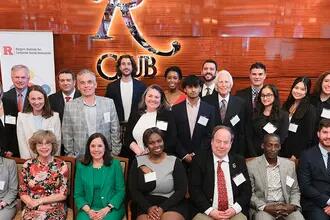
Business Insight: Why age, class and lived experience are also important components of DEI efforts
This piece was originally published by the Harvard Business Review on July 1. It was written by Noa Gafni, executive director of the Rutgers Institute for Corporate Social Innovation.
We are in the midst of a seismic shift when it comes to how companies address diversity, equity, and inclusion. This is, in part, due to the recognition that the strategies organizations have traditionally used to create more space at the table for historically excluded groups haven’t worked for some time. Getting this right has huge upsides, for employees, society, and the economy alike: According to McKinsey, narrowing the gender gap by 2025 would generate an additional $12 trillion in GDP and increasing financial inclusion for Black Americans would create approximately $2 billion in potential revenue.
But in addition to focusing on gender, race, ethnicity, and sexual orientation, leaders need to include a wider range of people their organizations have been ignoring, consciously or subconsciously. By broadening their definition of diversity, leaders can better identify, engage, and integrate individuals into their organizations. And according to a recent initiative I led as the Executive Director at Rutgers Institute for Corporate Social Innovation (RICSI), tomorrow’s employees will increasingly value this approach, too.
At RICSI, we focus on the role of business in society, and specifically educating students to embrace and champion a business world that “practices what it preaches” when it comes to diversity, equity, and inclusion. Our belief is that corporations have a better chance at achieving positive social impact when they hire leaders who believe in a marriage between profit and purpose — and that these leaders should have a breadth and depth of diverse experiences.
Our work is anchored in a commitment to equity and justice, as Rutgers is one of the country’s most diverse public universities. According to our most recent data, of the 7,975 undergraduate students on the Rutgers Newark campus (where RICSI is located), 28.9% identify as Hispanic, 18.4% as Black/African American, and 17.8% as Asian. The school has been ranked one of the nation’s most diverse campuses since 1997 and a top-three school for most first-generation college students in the U.S. These race and ethnicity statistics continuously make us one of the top three most diverse research institutions in the country.
Through our partnerships — both with students and companies that work with RICSI — we demonstrate how organizations might broaden their view of diversity. For example, in 2020, we surveyed 120 students who are part of our student advisory board following the murder of George Floyd. Through written responses and ongoing conversations, we discussed their thoughts as young, diverse leaders on how DEI efforts are packaged today in organizations.
Feedback ranged from encouraging leaders to hire Black executives for more C-suite roles — beyond a “Chief Diversity Officer” — to combining outreach into communities that are regularly ignored with implementing blind hiring processes. According to one of our students, “While companies are currently working on hiring more people of color as a whole, they are treated as a ‘check in the box.’”
For all they had to say on racial equity, however, their comments made it clear that a focus on traditional markers of diversity are not enough. Similar to developmental psychologist Howard Gardner’s multiple intelligences, our students expressed a need to expand the notion of diversity to include a number of additional factors — such as age, socioeconomic status, and lived experience.
We’ve used our own work at RICSI to pressure test how shifting the definition of diversity can bridge the gaps a traditional definition of diversity leaves behind. And we’ve seen success in looking at how our student body spans many diverse identifiers and how our hyperlocal solutions can help ensure they’re not left behind. For instance, we prioritize meet-and-greets between our students and business leaders because it ensures that students who may not have the ability to regularly network because of familial commitments or work responsibilities still have the same opportunities as their peers.
Solutions like these can be woven into ERG and HR tactics. Specifically, here are three areas of diversity that can serve as launching pads for new ways to hire and retain workers.
Age
Age discrimination isn’t new and there are many pieces of research that outline how prevalent it really is. An AARP survey found that 1 in 4 workers age 45 and over have been signaled out negatively for their age by managers or supervisors. On the other side of the spectrum, young employees may also feel left out of leadership roles or opportunities as a result of their age. Our students range from 18-61 years old, and many reported feeling excluded in some way.
Solutions start with acknowledging that older and younger students or employees have unique mountains to climb. Next steps can come from open conversations on how age discrimination impacts each group. For the younger demographic, one of the comments that struck a chord was a student describing the need for a better pipeline between students and the roles that are open to them. They observed that “the most well-connected workers and employees are more likely to end up attaining superior jobs” and that “internal mobility will help employee morale and increase advocacy for marginalized groups.” Indeed, studies have found that implementing an internal mobility program at a company helps build trust among employees, showing that the company, and its leadership, are invested in their growth and the skillset they already bring. Additionally, another student suggested a mentorship program that offers potential for growth into partner companies.
The common thread we saw across the board is a need to create systems where people on either end of the age spectrum have a clearer connection point to the decision-makers, each other, and the conversations around age at work. Some organizations are already onboard with this. The World Economic Forum, for instance, helps implement this working relationship through their Global Shapers Community, which connects young people with world leaders at Davos. At Coca-Cola, “reverse mentorship” programs allow those who may have historically felt too junior the opportunity to honestly express an idea or a concern without as much fear of retribution.
This points to the real value of diversity efforts: to help your organization dismantle past ways of doing things so that, in those gaps, new ideas and unique perspectives to arise. Today’s young people bring a unique perspective to these endeavors in particular, having grown up as digital natives and taking globalization for granted.
Organizations would do well to focus on age inclusion across the board:
- Find opportunities for younger workers to connect with senior executives on a level playing field. At RICSI, we connect our students to corporate leaders through small group interactions, for example, the kind normally reserved for “high-potential” middle managers.
- Develop a culture where innovation can thrive at all levels of the organization, not just from the top, and ensure there are multi-generational cohorts working on new products, services, and ideas
- Provide opportunities to experiment with new ideas or ways of working. For example, during Covid, many organizations started relying on employees at both ends of the age spectrum to support each other throughout the transition to remote working. Younger employees were often tasked with helping those on the opposite end of the spectrum embrace new technologies. And, as entry-level employees began to onboard virtually, organizations relied on tenured individuals to support these young employees’ transition into the workforce.
Socioeconomic Status
Our students at RICSI often speak out about how they feel excluded from opportunities as a result of their own socioeconomic status. Many of our students work and go to school, support their parents or other dependents, or are the main breadwinners for their families. Their dedication to making the business world a better place is unquestionable, as is their lack of time to take on internships that won’t pay or roles that disregard their current needs in addition to their future aspirations.
Research has historically shown that public universities are a force for social mobility, particularly among low-income students. The opportunity to continue on their growth trajectory after graduation becomes harder when so many institutions continue to focus on hiring solely from elite private institutions instead. The hiring cycle helps support the status quo of turning towards upper middle-class and wealthy student populations in order to fill everything from entry level to gatekeeper roles at organizations.
According to non-profit research organization at Harvard University, Opportunity Insights, we know that, “Ivy League colleges such as Columbia University…[have] more students come from families in the top 1% of the income distribution than the bottom half of the income distribution.” Data from the organization also shows that students from low and middle-income backgrounds tend to attend less selective schools than their peers from wealthier families, even when taking into account test scores.
Not only is there a recruitment issue that warrants a restructuring of how socioeconomic diversity realities are tackled, but many organizations, particularly in the social or startup sectors, also only offer unpaid or underpaid internships. Statistics show that 40% of internships at for-profit companies remain unpaid. Simultaneously, many full-time role descriptions list internships as a prerequisite. Both of these actions fail to account for the fact that an unpaid or underpaid internship is not financially feasible for many students.
In order to broaden the socioeconomic range of those who can apply to jobs and diversify workforces, we need to be able to address the systemic ways we’re making it impossible for students to do so if they come from a low-income background. Removing the barrier of entry that internship requirements impose can help broaden the range and diversity of graduates who may now qualify for the role through other lived experience or work experience.
This shift in thinking can benefit organizations enormously. As researchers Joan C. Williams, Marina Multhaup, and Sky Mihaylo note, the more diversity of socioeconomic backgrounds exists within a team, the more likely you are to expand the pool of perspectives, leading to more inclusive (and better) decision-making. We need teams that reflect the customers and communities we are trying to serve. Perspective from a single socioeconomic background cannot provide this.
The hiring pool is destined to stay the same unless organizations extend beyond the shortlist of schools, cities, or experience, ideal candidates should have on their resume. They can do this by committing and taking tangible steps to hire from diverse socioeconomic backgrounds, such as:
- Broadening search placements, like advertising roles at public universities.
- Using hiring processes that remove markers such as prestigious brand name universities or companies on resumes
- Providing competitively paid internship and entry-level opportunities, or make internship opportunities less of a requirement and focus on other experience instead.
Lived Experience
As I previously mentioned, my institute engages with students that have a range of unique backgrounds. One of our students is a single parent who has experienced food and housing insecurity. Another is an Army veteran. Several are immigrants. And many are considered “untraditional students” in that they did not directly enter tertiary education after high school. They all bring a range of perspectives, and their insights, experiences, and depth of understanding shape our thinking and ways of working. These are their lived experiences — episodes in their lives that have shaped how they view the world, the lens through which they problem solve, or the leadership qualities that they were taught outside of textbooks.
These perspectives are vital at all levels of an organization, whether we’re talking about staffing a board, team, or student body — lived experience should be embraced, not discounted. According to social impact entrepreneur Amy Neumann, lived experience can even help a board better serve the organization and its stakeholders, particularly if board members are part of the community the company serves.
Disrupting our way of thinking about “experience” generally can help ensure that we do not discount the added value of someone’s personal experience with the problems at hand. Diversity efforts can fail when we don’t do this by assuming that only those with brand name associations have solutions to an organization’s biggest problems. At RICSI, we’ve seen the benefits of intentionally working to broaden our own understanding of lived experience through the lens of diversity. Whether we are engaging with local, grassroots leaders or global social innovators, our students with lived experience provide insights that are not obvious to outsiders. These insights are invaluable — and relevant across organizations or institutions.
Organizations can address this by:
- Asking the right questions. Oftentimes, individuals with proximity to certain issues may not feel comfortable sharing, so framing and asking about it in a positive light can encourage those with lived experience to share more about their background. For example, an organization can ask about a candidate’s passion for a particular issue, delving into their background and level of familiarity
- Creating new pathways to leadership opportunities, such as by identifying “high potential” individuals in partnership with community groups, scholarship programs, etc.
- Removing a mandatory “years of experience” where possible so that the right candidates aren’t disqualified simply because they may not look good on paper at first glance.
When organizations collectively decide to broaden the perspectives on what diversity can mean, it’s easier to understand that lived experience should be considered as an important counterpart to “traditional” — or university or work-earned — knowledge.
As one of our students eloquently put, “The first step towards progress is acknowledging the past and current injustices and asking the question ‘What can we do to elevate your voices?’” Acknowledging that we have multiple ways to approach diversity is our first step to expanding efforts towards greater inclusion. Age diversity, socioeconomic status, and lived experience are just three lenses leaders can use to create strategies for meaningful social impact within companies. These lenses, when considered in addition to race, ethnicity, and gender, can build a more holistic view of what diversity means — and drive lasting change accordingly.
Noa Gafni is the executive director of the Rutgers Institute for Social Corporate Innovation.
Press: For all media inquiries see our Media Kit


